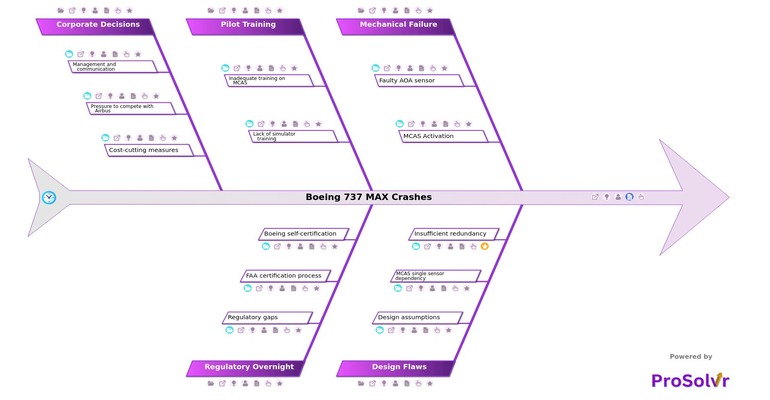RCA of Boeing 737 Max Crashes
The Boeing 737 Max crashes refer to two tragic incidents involving the Boeing 737 Max aircraft, leading to a global grounding of this model's entire fleet. Leveraging tools like ProSolvr for Visual Root Cause Analysis can help dissect and address the causes of these crashes. Using Root Cause Analysis (RCA) techniques such as the Fishbone Diagram (Ishikawa diagram) is crucial for thoroughly understanding the contributing factors and ensuring robust safety improvements.
The first incident involved Lion Air Flight 610 (JT610), which occurred on the 29th of October, 2018, over the Java Sea near Jakarta, Indonesia. All 189 passengers and crew members on board lost their lives. The crash was primarily attributed to a malfunction in the Maneuvering Characteristics Augmentation System (MCAS), which repeatedly pushed the plane's nose down due to erroneous readings from a single angle of attack (AOA) sensor. The pilots struggled to regain control but were unable to counteract the MCAS inputs.
The second incident involved Ethiopian Airlines Flight 302 (ET302), which occurred on the 10th of March, 2019, near Bishoftu, Ethiopia. 157 passengers and crew members lost their lives. Similar to the Lion Air crash, this incident was also caused by issues with the MCAS system, which was erroneously activated due to faulty AOA sensor inputs, leading to repeated nose-down commands that the pilots struggled to overcome.
Following the Ethiopian Airlines crash, aviation authorities worldwide grounded the Boeing 737 Max fleet. Investigations revealed significant flaws in the MCAS system design and inadequate pilot training to handle a malfunction of this system. Boeing faced intense scrutiny and was required to make extensive software updates to the MCAS system, improve pilot training, and address other safety concerns. The 737 Max was eventually cleared to return to service in late 2020 and early 2021 after regulatory authorities approved the changes.
The crashes severely damaged Boeing's reputation, leading to financial losses, legal settlements, and a loss of public trust. Boeing also had to provide compensation to the victims' families and to airlines affected by the grounding. These crashes underscore the importance of rigorous safety standards and thorough pilot training and awareness of new aircraft systems. ProSolvr, an AI-powered root cause analysis tool that uses fishbone templates, can visually map out the different causes that contributed to the problem effectively and efficiently.
Who should use the Boeing 737 Max Crashes template?
Why use the Boeing 737 Max Crashes template?
RCA, with the help of a Fishbone template, can visually map out the different causes that contributed to the problem. Tools like ProSolvr by smartQED, based on Six Sigma principles, can help analyze these causes effectively.
By using a reliability tool like ProSolvr, stakeholders can gain a comprehensive understanding of the multifaceted causes of the Boeing 737 Max crashes. Authorities can systematically identify and address the root causes, leading to improved safety and prevention of similar incidents in the future. It can help them take preventive measures and work on corrective actions as well.
Create or customize your templates for problem analysis in ProSolvr by smartQED.
Curated from community experience and public sources:








